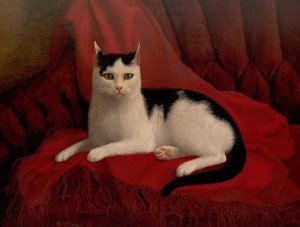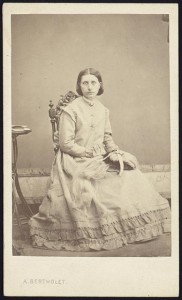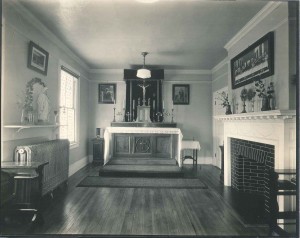
Now that I have the undivided attention of the cat-hungry Internet, I will admit that the charming cat pictured is not the subject of this post. Alas! I will instead be introducing you to one of my favorite Brookland figures and the painter of this furry portrait, Antoinette Margot. Margot was an artist, humanitarian, and Brookland fixture in the early twentieth century.
Born in 1843 in Lyons, France, she was raised in a strict Protestant Huguenot household. Her early life was devoted to painting, at which she excelled. (It would continue to be a lifelong hobby, as she created images of family members and saints.) Margot, however, wanted to help people, and with the outbreak of the Franco-Prussian War in 1870, she volunteered as a nurse with the then-new International Red Cross. It was in this capacity that she met an American by the name of Clara Barton, the legendary Civil War nurse and future founder of the American Red Cross. Over the course of the next several years, Barton and Margot would forge a close relationship, as they witnessed the horrors of the conflict and became roommates after the war.

When Barton departed to America in 1873, Margot returned to her parents’ home in Lyons, where she underwent a spiritual conversion. Upon joining the Catholic Church, she entered a convent in 1874. Ill health and familial pressure forced her to leave the religious order in 1877. After this taxing experience, she made her way to the United States in 1885, moving first to New York and later to Washington, DC with Barton.
Proving the old adage that one should never room with one’s friends, religious differences and conflicts of personality quickly emerged between the two. Parting company with her wartime colleague, Margot struggled to adopt to her new country, eventually finding a home in the Brookland neighborhood.
Focusing her energies locally, Margot settled in the neighborhood with Leonid Delarue, purchasing land and constructing a house – named Theodoron. The two woman, along with Delarue’s mother, moved into the house in 1891. With no local parish in Brookland, local residents often attended mass at the nearby Caldwell Chapel on the new Catholic University campus. Shortly after moving into Theodoron, however, Margot offered space in her house as a chapel for Catholic services. Her newfound friend, Semitic Languages professor and fellow Lyons native Fr. Henri Hyvernat, would sometimes offer these services.

Together, Hyvernat and Margot helped fundraise and advocate for the creation of a neighborhood church. By providing the impetus for the founding of this new parish, christened St. Anthony’s, Margot left an indelible mark on the neighborhood. At the suggestion of Cardinal Gibbons, when the church was dedicated in 1896, it was even named in honor of Antoinette Margot’s contributions.
Over the remainder of her life, Margot would become a fixture in the Brookland neighborhood, passing away in 1925. Her longtime friend, Hyvernat, would act as the executor of her estate. Like her famous colleague, Miss Barton, Margot experienced traumatic upheavals in her life and suffered from serious bouts of depression, but as evidenced by the large number of photos she kept of friends and her beloved neighborhood, she continuously cared for those around her.
There are always surprises when searching through an archive – unexpected collections, strange letters, or beautiful artwork. For me, discovering Margot’s papers was an exciting moment. One of my first archival experiences was volunteering at the American Red Cross archives in DC. In the process, I learned a lot about the life of the Clara Barton and her many exploits. I also happened across the name of Antoinette Margot, a shy and devout French woman Barton had befriended. Therefore, getting both sides of their complicated relationship was illuminating! In addition finding paintings of cats, these are the types of connections that make archival work amusing.

4 thoughts on “The Archivist’s Nook: What Do the Semitics Department, the Franco-Prussian War, and this Dashing Cat All Have in Common?”
Comments are closed.